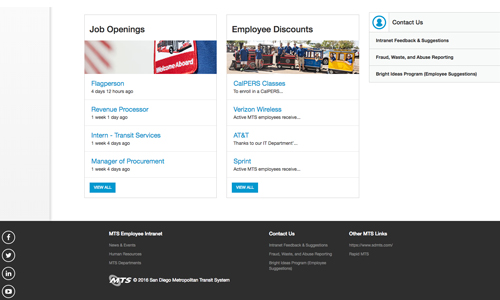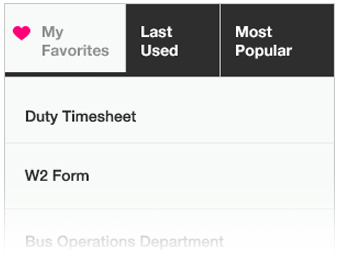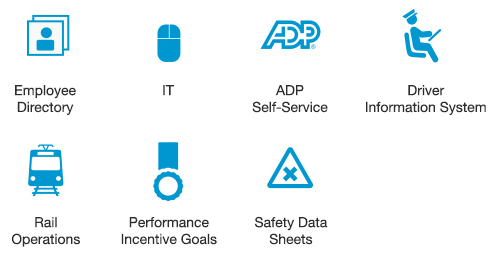
Information Technology Infrastructure Library (ITIL) framework
Click on the collapsible panel to open and close it.
The Information Technology (IT) Department at MTS has committed to using the Information Technology Infrastructure Library (ITIL) framework to ensure the efficient and effective alignment of technology capabilities and resources with agency goals. The ultimate goal of ITIL is to improve how IT delivers and supports valued business services and focuses on improving the capabilities of people, process, and technology.
The focus for the IT Department is to provide cost savings, value delivery and business transformation to the Agency through the use of technology. ITIL Service Management is a recognized professional practice which is supported by an extensive body of knowledge, experience and skills. The ITIL Service Management framework provides principles and practices to help IT service providers deal with current challenges.
ITIL Service Management provides common practices for provisioning business and core services that unites all teams toward a single goal which is to deliver business value. Its focus is on recognizing each service as a commodity and what each service brings to the business in terms of its value and benefit. It also acts as a check that can be used to verify that IT is providing the services that the Agency needs to meet business goals.
ITIL provides a set of consistent and comprehensive best practice guidance for business and IT service management (ITSM). ITIL is flexible and scalable and is suitable for all organizations and can be implemented in part or in whole to deliver business benefit in stages. MTS is in the early stages of adopting this approach.
A service is defined as a means of delivering value to customers by facilitating the outcomes that customers want to achieve, without the ownership of specific costs and risks. In order to meet the challenge of delivering services as demands for services change with business needs, the IT service provider needs to be able to adapt and respond effectively to those business needs.
Service management is defined as a set of specialized organizational capabilities for providing value to customers in the form of services. These capabilities enable the IT service provider to ensure the production and delivery of quality services that meet the needs of their customers in a timely and cost-effective manner.
IT Service Management (ITSM) is a process-based practice intended to align the delivery of information technology (IT) services to meet the needs of the Agency and emphasis the benefits to clients. The ITSM framework focuses on a process based approach to delivering services.
ITIL Service Management provides a body of knowledge providing common practices for the Agency to apply. It demonstrates a systematic approach that is responsive, consistent and measurable. Benefits to the Agency include:
1. ITIL is proven and used worldwide
ITIL defines common concepts and terms within an integrated set of best practices that evolves to meet needs in a cycle of continual improvement. Using ITIL works in practice as its adoption provides individuals and organizations with the confidence to take action.
2. Improved customer satisfaction and relationships
ITIL is designed to help everyone to focus their attention on the needs of the customers and user experience rather than focusing too much on the technology issues. Increasing customer satisfaction leads to a better and trusted relationship.
3. Better reliability and quality of service
By adopting standards that are proven to work, IT can more easily deliver services consistently to the agreed service levels, efficiently and effectively. Support teams can restore services faster thereby reducing downtime and service disruption. Support teams are also more capable of meeting their service levels, contractual, regulatory and legal compliance requirement.
4. Optimization of service delivery across the Agency
ITIL offers significant opportunities for simplification and standardization across the Agency. ITIL provides processes and models to help IT to work with the Agency, customers, users and suppliers to make sound business decision on investment opportunities, cost optimization, risk management and priorities for improvement.
5. Competitive advantage through value creation and agile change
By adopting ITIL service lifecycle practices, IT can focus on delivering value to the customer and quickly adopt change for the business and IT. Defining and managing the customer and service portfolios enables successful business transformation and growth with an increased competitive advantage.
6. Creates clear accountability through the definition of roles and responsibilities
7. Conformance to IT governance and compliance
The adoption of ITIL Service Management practices can aid the interaction between the product or service and the key business users and focuses on the:
1. Basic utility of the product or service and its ease of use
2. Fitness of the product or service for the business purpose
ITIL Service Management provides guidance on best practices in both of these areas which are then leveraged to optimize the consistency and sustainability which is the key to overall customer satisfaction.
ITIL defines five core service lifecycle modules that define processes and functions that are used to provide an integrated approach to service management. Each stage relies on service principles, processes, roles and performance measures and each state is dependent on the other lifecycle stages for input and feedback.
A constant set of checks and balances throughout the Service Lifecycle will ensure that IT can adapt services and respond effectively to changes in agency technology related needs. Implementing a service lifecycle provides structure, stability and strength to improve the service management capabilities of an organization.
The service lifecycle modules are:
Service Strategy sits at the core of the Service Lifecycle and focuses on ensuring that the MTS strategy is defined, maintained and then implemented. There is key guidance for Executive Managers’ around operating according to the business constraints, corporate governance and compliance, legislation, and some cultural aspects of organizational transformation. This focus will enable practical decision making, based on a sound understanding of the services offered and helps IT improve and develop over the long term.
Service Strategy is about ensuring that organizational units in support of the business are in a position to handle the costs and risks associated with their service portfolio, and that they are set up for service improvement.
During Service Design, the focus is placed on converting the strategy into reality, through the use of a consistent approach to the design and development of new service offerings:
• A consistent use of a common architecture
• Understanding and translating the business requirements
• Introducing the appropriate Support requirements upon implementation of the service
The scope of Service Design is not limited to new services; it includes any changes and improvements necessary to increase or maintain value to customers over the lifecycle of services, such as improved continuity of a service, or improvements necessary to enhance service hours and service levels. Changes required because of new conformance standards and regulations are also relevant as are services bought off the shelf from suppliers.
As design and development activities are completed, there is a period for Service Transition with its key purpose to bridge both the gap between projects and operations more effectively, but also to improve any changes that are going into live service, even if it is transferring the control of services between customers and service providers.
The Service Transition stage brings together all the assets within a service and ensures these are integrated and tested together. Its focus is on the quality and control of the delivery of a new or changed service into operations. Giving sufficient time and quality effort to this stage of the lifecycle will reduce unexpected variations in delivery of the live services.
The operational teams ensure there are robust end-to-end practices which support responsive and stable services. They provide on-going support and they are a strong influencer on how the business perceives the service it receives. A key part of this is the Service Desk that directly own and support incident management and request fulfillment for users, including feedback on user satisfaction. Supporting functions to the Service Desk include business support and administration teams
• Continual Service Improvement
Continual Service Improvement works with the other four stages of the service lifecycle to align the services with the business needs, while recognizing improvement opportunities and change.

 Employee Directory
Employee Directory IT Help Desk
IT Help Desk ADP Self-Service
ADP Self-Service Driver Information System
Driver Information System Bus Operations
Bus Operations Rail Operations
Rail Operations Performance Incentive Program
Performance Incentive Program Safety Data Sheets
Safety Data Sheets




